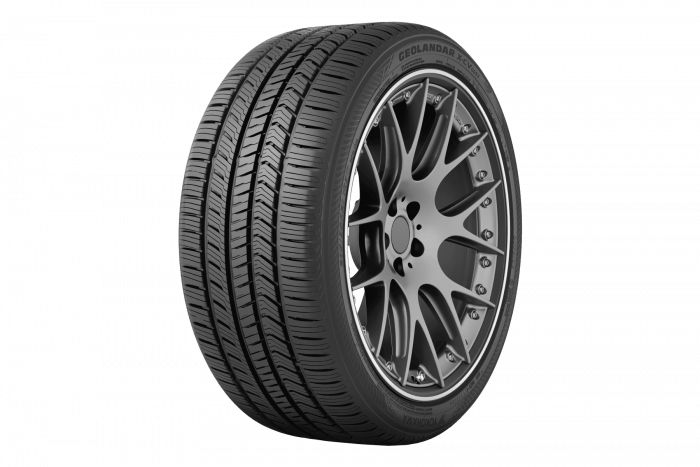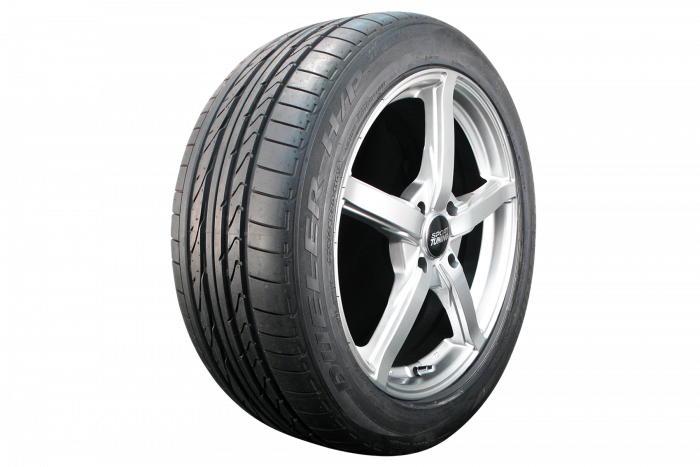BMW X5 is an iconic European crossover, one of the first of its kind, in fact. Naturally, it’s been thoroughly explored over the years, and all the strengths and preferences are now widely known. The car is very capable both for highway driving and off-road travelling. Most drivers prefer the former, however.

Like the car itself, the tires for X5 have many variations, properties and purposes. There are so many of them, you’ll be hard-pressed to find a set of tires that would fit your style and preferences. Because of this difficulty, we’ve gathered a few respectable options with varying goals, strengths and weaknesses.
Bridgestone Dueler HL 400 RFT
Upsides:
- Outstanding summer performance;
- Stability and responsive handling;
- Pretty comfy and quiet
Downsides:
- Durability unclear
To start off, Dueler HL is a reliable option for occasional highway trips. In summer, this one will provide efficient grip both in rainy and clear weather. It snow, it’s only really viable if it’s not too deep – only for cautious drivers, then.
It excels when you need to use your car’s mobility and maneuvering, because they are pretty obedient and easy to control. On top of that, a reasonably comfortable and quiet nature of theirs makes sure you have a good time driving many-mile trips.
They aren’t very useful if you intend on using them all the time, though – for durability concerns, if not other reasons.
Michelin Latitude Tour HP ZP
Upsides:
- Stability and responsive handling;
- Outstanding grip in all situations;
Downsides:
- Noisy, for the most part;
- Short tread life
Latitude Tour HP ZP is an improvement in several key aspects. For one, it’s absolutely killing competition when it comes to gripping capabilities – in dry, wet and even snow. In addition, it’s as responsive and obedient as most high-class and high-performance tires.
But then, because it’s considered a run-flat tire, the warranty is basically half of what it’s supposed to be. The expected minimal mileage is around 50,000 km. However, if it pops before that, you’ll be able to reach its projected lifespan no problem – it is a run-flat tire, after all. The problem is that, after it’s punctured, the tire will suddenly become worse.
Bridgestone Blizzak LM-60 RFT
Upsides:
- Extremely good in winter;
- Decent in summer;
- Outstanding handling
Downsides:
- None
Blizzak tires are meant for driving over snow and ice, but it’s not their main prerogative. Although handling and grip are superb in the winter conditions, you can still very safely drive in these in summer – both in rainy and clear weather.
But it’s true – the ice and snow are where these tires shine the brightest. They are considered one of the best snow tires, and given that not many of them fit BMW X5 (owing to its size and weight), Blizzak LM-60 RFT remains one of the better choices if you need extra traction in winter.
Yokohama Geolander X-CV
Upsides:
- Excellent off-road performance;
- Great on-road behavior;
- Not too loud;
- Durability
Downsides:
- None
Geolander is an interesting case. BMW X5 can’t really afford going off-road full-time – it needs to be on a paved road at least half the time. That’s why, if you want to go off-road without switching tires, you’ll need one of these. Geolanders are great in mud, dirt, gravel and other off-road surfaces, but it’s also very capable to drive on-road harmlessly.
On the road, they are as quiet and smooth as mud tires can feasibly be without compromising on their all-terrain properties too much. It’s also extremely good when it comes to grip – both dry and wet. It’s even somewhat competent in the snow, owing to its digging potential.
Continental CrossContact LX25
Upsides:
- Outstanding all-round performance;
- Perfectly smooth driving;
- Durability;
- Noiseless
Downsides:
- None
CrossContact is an optimal tire for a car such as BMW X5. The tread grips the ground very tightly, both in snow, ice, dry and wet. Regardless of what may befall you, your tires will be fine. Even more so, considering they ride extremely smoothly and almost noiselessly.
There are some minor drawbacks of course, but none are really crucial. What is crucial is that LX25 is pretty long-lasting in addition to everything else. The warranty is about 115,000 km, which is very pleasant for a good tire such as this.
Pirelli Scorpion Verde All-Season
Upsides:
- Great summer grip;
- Great winter grip;
- Responsive handling;
- Quiet
Downsides:
- Not too comfy
We’re slightly entering the realm of touring tires, now. Scorpion Verde provides outstanding response in any situations. The performance is really worth being called ‘all-season’, seeing how well they behave on dry, wet and even snowy ground.
Admittedly, the comfort could be better. These tires are particularly noisy, that’s true – but they are pretty stiff, which means your backside will feel every little bump on the road. And, what’s more, you can’t know for how long these tires will hold. Basically, it’s a bit risky bargain, but worth it for harsher winters.
Pirelli Scorpion Verde All-Season Plus II
Upsides:
- Outstanding summer performance;
- Decent winter grip;
- Very responsive handling;
- Quiet and comfy
Downsides:
- None
Verde AS Plus II is, as you might’ve guessed, an improvement upon the legacy of Verde AS. It’s now much better in summer (especially in rainy weather), decent on snow (if it’s shallow enough) and extremely responsive in handling and steering. It’s closer to the sports tires now, although these are still not very stable at higher speeds.
It’s also not uncomfortable to drive in now, but just as noiseless. The durability could admittedly be better – the warranty only goes up to 115,000 km. It could absolutely be higher, but could also be lower, knowing Pirelli.
Goodyear Eagle F1 Assymetric
Upsides:
- Superb responsiveness and handling;
- Excellent grip;
- Short braking distance
Downsides:
- Inferior durability
Goodyear Eagle F1 is called so because it’s fit for use in Formula 1. How do they figure that? Well, first off, these tires are amongst the best controlled in the industry. The handling is absolutely outstanding, and steering is unprecedented. If you want a car to go somewhere, it’ll be there within a moment.
We are encroaching onto the UHP category now, actually. Everything fits – the grip is superb in wet and dry conditions. The road feel is superb, which also means the braking distance is minimal. But then, because it’s a high-performance tire, the durability is much lower than usual. They don’t even give you warranty, for all its worth.
Bridgestone Dueler HP
Upsides:
- Outstanding grip in wet and dry;
- Impeccable handing;
- Outstanding stability;
- Quiet and comfortable
Downsides:
- High price;
- Not durable
Dueler HP is considered a sports tire, actually. So, you can expect most good features that the sports tires usually have – i.e. impressive steering, fantastic traction (both in dry and in wet, in this case), noiselessness and smoothness. Notably, all of these characteristics are much better on Dueler than on most other tires.
Obviously, all of these positive additions made the price higher than you’d usually expect from a sports tire. Again, just like you’d expect, Dueler HP is not a very durable tire. The exact mileage is unclear, but they don’t seem to excel even 80,000 km.
Michelin Premier LTX
Upsides:
- Fantastic handling and stability;
- Superb dry performance;
- Decent wet performance;
- Quiet and comfy
Downsides:
- Costly
Michelin Premier LTX is considered one of the premium touring tires this company has in stock. They are basically as obedient at high speeds as at lower velocity. On top of that, they always behave great on dry and wet land. Snow traction isn’t as superb, but you can’t really complain.
To top it all, while you’ll be speeding in your X5 with these guys on, you won’t hear much noise or feel anything below you. The supreme comfort is guaranteed. The only problem is that they are costly, and the pleasure is not too long in this world, because the min. mileage is only 100,000 km. It’s not too low, but it could be so much longer.
Continental CrossContact UHP
Upsides:
- Impressive responsiveness;
- Outstanding dry performance;
- Decent wet performance
Downsides:
- None
CrossContact UHP is a decent ultra-performance tire. There are better options when it comes to comfort or to grip or handling, although all of these qualities are very healthy and balanced in this Conti tire. Basically, the tread is extremely obedient and grippy in clear weather and also pretty good during rains.
As far as ultra-performance tires go, this one isn’t very comfortable on the road (at least, when compared to other options). At the very least, it’s not disappointing when it comes to durability. It’s unknown for how long they usually last, but it’s much longer than the usual sports tires, for sure.
Michelin Pilot 4 SUV
Upsides:
- Flawless summer grip;
- Outstanding handling;
- Quiet and smooth;
- Very stable
Downsides:
- Not at all durable
Michelin Pilot 4 is an extreme solution for X5 drivers who want nothing more than ride through a roadway at sweeping speed. In summer, and especially in dry days, you can expect impeccable grip and control – amongst the best across ultra-performance tires. In wet, the performance is pretty tolerable, but don’t ever use them in snow.
This stable and comfortable tire has only one weakness – the longevity, or rather the lack of it. It only has about 30,000 km to go, and it’s the smallest number throughout this whole list. It’s only good for one or two summers of constant use.












